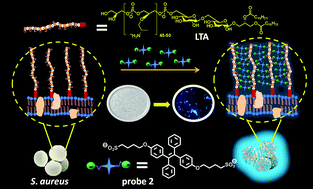当前位置:
X-MOL 学术
›
Mater. Chem. Front.
›
论文详情
Our official English website, www.x-mol.net, welcomes your
feedback! (Note: you will need to create a separate account there.)
Sulfonate-functionalized tetraphenylethylenes for selective detection and wash-free imaging of Gram-positive bacteria (Staphylococcus aureus)†
Materials Chemistry Frontiers ( IF 6.0 ) Pub Date : 2018-09-17 00:00:00 , DOI: 10.1039/c8qm00417j Viraj G. Naik 1, 2, 3, 4, 5 , Sharanabasava D. Hiremath 1, 2, 3, 4, 5 , Avijit Das 4, 5, 6 , Dishant Banwari 1, 2, 3, 4, 5 , Ram U. Gawas 1, 2, 3, 4, 5 , Malabika Biswas 4, 5, 6 , Mainak Banerjee 1, 2, 3, 4, 5 , Amrita Chatterjee 1, 2, 3, 4, 5
Materials Chemistry Frontiers ( IF 6.0 ) Pub Date : 2018-09-17 00:00:00 , DOI: 10.1039/c8qm00417j Viraj G. Naik 1, 2, 3, 4, 5 , Sharanabasava D. Hiremath 1, 2, 3, 4, 5 , Avijit Das 4, 5, 6 , Dishant Banwari 1, 2, 3, 4, 5 , Ram U. Gawas 1, 2, 3, 4, 5 , Malabika Biswas 4, 5, 6 , Mainak Banerjee 1, 2, 3, 4, 5 , Amrita Chatterjee 1, 2, 3, 4, 5
Affiliation

|
Two sulfonate functionalized tetraphenylethylene (TPE) derivatives were synthesized and used as probes for the detection and imaging of Gram-positive bacteria (e.g. Staphylococcus aureus). The strategy is based on AIE-based turn-on fluorescence resulting from simple electrostatic interactions between the negatively charged probe and positively charged functionalities of lipoteichoic acid (LTA) which is a major component of the outer cell wall of Gram-positive bacteria. TPE-mono-sulfonate (1) and TPE-di-sulfonate (2) both exhibited fast detection ability but the latter, owing to its high-water solubility and higher sensitivity, is the preferred probe for fluorimetric studies and wash-free bacterial imaging. Probe 2 efficiently interacts with the cell-wall of Gram-positive bacteria (S. aureus or B. subtilis) and the bacteria fluoresce blue, whereas, it showed negligible response to both Gram-negative and acid-fast bacteria. Up to 43 fold increase in fluorescence intensity was observed for probe 2 within the bacterial concentration of 0–12 × 108 CFU mL−1. Interestingly, probe 2 showed significant antibacterial activity against S. aureus with an MIC of 23.4 μg mL−1. This simple strategy is advantageous in many ways such as cost-effectiveness and easy synthesis, high water solubility of the probe, fast response, etc. and can be applicable for real sample analysis which is demonstrated by artificially contaminating apple juice with S. aureus.
中文翻译:

磺酸盐官能化的四苯乙烯用于革兰氏阳性菌(金黄色葡萄球菌)的选择性检测和免洗成像†
合成了两种磺酸盐官能化的四苯乙烯(TPE)衍生物,并用作探针用于革兰氏阳性细菌(例如金黄色葡萄球菌)的检测和成像。该策略基于基于AIE的开启荧光,该荧光是由带负电荷的探针和脂联磷酸(LTA)的带正电功能之间的简单静电相互作用产生的,脂联磷酸是革兰氏阳性细菌外细胞壁的主要成分。TPE-单磺酸盐(1)和TPE-二磺酸盐(2)都具有快速检测能力,但后者具有高水溶性和较高的灵敏度,是荧光分析和免洗细菌成像的首选探针。探针2与革兰氏阳性细菌(金黄色葡萄球菌或枯草芽孢杆菌)的细胞壁有效相互作用,细菌发出蓝色荧光,而对革兰氏阴性细菌和耐酸细菌的反应却微不足道。在细菌浓度为0–12×10 8 CFU mL -1的情况下,探针2的荧光强度提高了43倍。有趣的是,探针2显示出对金黄色葡萄球菌的显着的抗菌活性,MIC为23.4μgmL -1。这种简单的策略在许多方面都具有优势,例如成本效益高,易于合成,探针的水溶性高,响应速度快等。并且可以应用于真实样品分析,这可以通过用金黄色葡萄球菌人工污染苹果汁来证明。
更新日期:2018-09-17
中文翻译:

磺酸盐官能化的四苯乙烯用于革兰氏阳性菌(金黄色葡萄球菌)的选择性检测和免洗成像†
合成了两种磺酸盐官能化的四苯乙烯(TPE)衍生物,并用作探针用于革兰氏阳性细菌(例如金黄色葡萄球菌)的检测和成像。该策略基于基于AIE的开启荧光,该荧光是由带负电荷的探针和脂联磷酸(LTA)的带正电功能之间的简单静电相互作用产生的,脂联磷酸是革兰氏阳性细菌外细胞壁的主要成分。TPE-单磺酸盐(1)和TPE-二磺酸盐(2)都具有快速检测能力,但后者具有高水溶性和较高的灵敏度,是荧光分析和免洗细菌成像的首选探针。探针2与革兰氏阳性细菌(金黄色葡萄球菌或枯草芽孢杆菌)的细胞壁有效相互作用,细菌发出蓝色荧光,而对革兰氏阴性细菌和耐酸细菌的反应却微不足道。在细菌浓度为0–12×10 8 CFU mL -1的情况下,探针2的荧光强度提高了43倍。有趣的是,探针2显示出对金黄色葡萄球菌的显着的抗菌活性,MIC为23.4μgmL -1。这种简单的策略在许多方面都具有优势,例如成本效益高,易于合成,探针的水溶性高,响应速度快等。并且可以应用于真实样品分析,这可以通过用金黄色葡萄球菌人工污染苹果汁来证明。











































 京公网安备 11010802027423号
京公网安备 11010802027423号